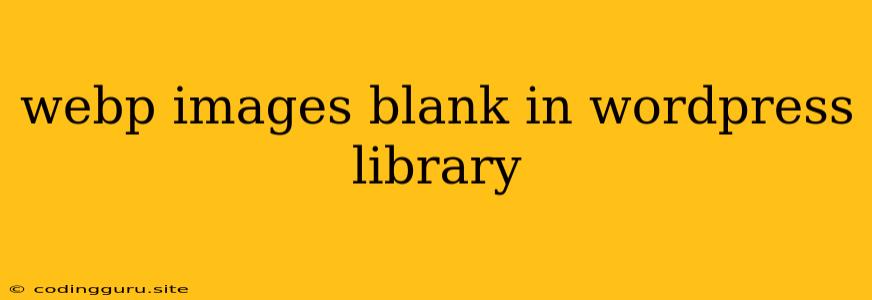Why are my WebP images showing up blank in my WordPress media library?
You've successfully implemented WebP images for a smoother, faster website experience. However, you're greeted with a frustrating sight: blank placeholders where your WebP images should be in the WordPress media library. This can leave you scratching your head and wondering what went wrong.
Let's break down the common reasons why WebP images might appear blank in your WordPress media library and how to troubleshoot them:
Understanding WebP & WordPress
WebP, a modern image format developed by Google, offers significant advantages: smaller file sizes, better compression, and superior visual quality. This makes WebP ideal for speeding up your website. However, WordPress, while being incredibly versatile, doesn't natively support WebP image previews within the media library.
Troubleshooting WebP Image Issues in the WordPress Media Library
1. Image Compatibility:
- Incorrect WebP Encoding: If your WebP images are not properly encoded, WordPress might struggle to recognize them. Ensure you're using reliable tools to convert your images to WebP format.
- Image Size Limits: Verify that your WebP images are within the size limits set by your WordPress hosting provider. If they exceed the limits, they might not display correctly.
2. Plugin Conflicts:
- Conflicting Image Optimization Plugins: Some image optimization plugins, especially those focused on other formats like JPEG or PNG, might interfere with WebP image previews. Temporarily disable any such plugins to see if that resolves the issue.
- Outdated Plugins: Make sure all your plugins, including those related to image optimization, are up-to-date. Outdated plugins can cause compatibility issues.
3. Server Configuration:
- WebP Support: Your web server needs to be configured to support WebP. Most modern web servers (Apache and Nginx) have support for WebP.
- .htaccess Configuration: Check your
.htaccessfile to ensure it properly handles WebP requests. You might need to add specific rewrite rules to direct the server to recognize and display WebP images.
4. Browser Issues:
- Browser Compatibility: While most modern browsers support WebP, some older versions might not. Test your website across different browsers to see if the WebP images display correctly.
- Cache Clearing: Clear your browser cache and cookies to ensure you're not viewing an outdated version of your website.
5. Image File Naming:
- Correct Extension: Double-check that your WebP images have the correct file extension:
.webp. Any incorrect extension might confuse WordPress and cause issues.
6. WordPress Media Library Settings:
- Media Library Settings: WordPress media library settings might influence how images are displayed. Review those settings, especially the 'Image Size' options.
Practical Solutions
- Using a Dedicated WebP Plugin:
- Several dedicated WebP plugins are available to enhance WebP support in WordPress. They help with conversion, optimization, and display.
- Customizing Your
.htaccessFile:
- You can manually edit your
.htaccessfile to add rules for handling WebP images:RewriteEngine On RewriteCond %{HTTP_ACCEPT} image/webp RewriteRule (.+)\.(jpg|jpeg|png)$ $1.webp [T,L,QSA]
- Adjusting WebP Conversion Settings:
- If you're using a dedicated WebP plugin, experiment with its settings. The quality and compression levels might affect how your WebP images are handled in WordPress.
- Testing and Experimentation:
- The best approach is to thoroughly test your WebP image implementation. Disable and re-enable plugins, adjust settings, and observe the changes in your WordPress media library.
Important Note:
- If you are using a CDN (Content Delivery Network), make sure your CDN also supports WebP. Configure your CDN to serve WebP images when appropriate.
Example: Addressing a Conflicting Plugin
Let's say you are using a popular image optimization plugin that focuses on JPEG and PNG formats. You might be experiencing issues with WebP image previews. In this scenario, temporarily disabling the image optimization plugin will isolate the potential conflict. If the WebP images start displaying correctly, you know the issue is related to that plugin.
Conclusion
WebP images are an excellent way to improve your website's performance. While WordPress doesn't natively support WebP previews in the media library, you can still use them effectively by troubleshooting common issues. Remember, troubleshooting often involves a process of elimination, so be patient and test different approaches until you find the solution that works best for your website.
